Body dysmorphic disorder: symptoms, causes, and treatments
Table of content
- What is body dysmorphic disorder?
- What are the symptoms of body dysmorphic disorder?
- What are the causes of body dysmorphic disorder?
- What are the risk factors for body dysmorphic disorder?

Body dysmorphic disorder is a preoccupation with one’s appearance, especially with a perceived flaw or defect that other people can’t see. Individuals with this disorder constantly worry about their appearance, which gives them a great deal of distress and anxiety.
The exact causes of body dysmorphia are unknown. A combination of factors such as genetics, abnormal brain function, and negative experiences in childhood contribute to the development of body dysmorphic disorder.
The most common treatment approaches for body dysmorphic disorder are cognitive-behavioral therapy and medications such as selective serotonin reuptake inhibitors (SSRIs). Healthcare professionals prescribe other types of medications depending on a patient’s symptoms. Proper treatment of BDD requires strong adherence to the treatment protocol. One’s support system additionally plays a huge role in the treatment of BDD.
What is body dysmorphic disorder?
Body dysmorphic disorder (BDD) is a mental health condition wherein a person can’t stop thinking about one or more perceived flaws in their appearance, even though others see nothing wrong.
The condition was first described in 1891 by Italian psychiatrist Enrico Morselli. He named the disorder dysmorphophobia, which derived from the Greek word dysmorphia (ugliness, misshapenness).
As an anxiety disorder, BDD is closely related to obsessive-compulsive disorders (OCDs). In fact, the American Psychiatric Association’s Diagnostic and Statistical Manual of Mental Disorders, fifth edition (DSM-5) classifies BDD among obsessive-compulsive and related disorders.
Everyone thinks they have some flaws or imperfections in appearance at one point or another. Not everyone has BDD. In people with body dysmorphia, the reaction to the perceived flaw is distressing and overwhelming. Negative or irrational thoughts associated with appearance become difficult to control.
A person with BDD spends hours worrying about how they look. To fix the problem, a person undergoes various cosmetic procedures, but in most cases, they aren’t satisfied with the results.
What are the symptoms of body dysmorphic disorder?
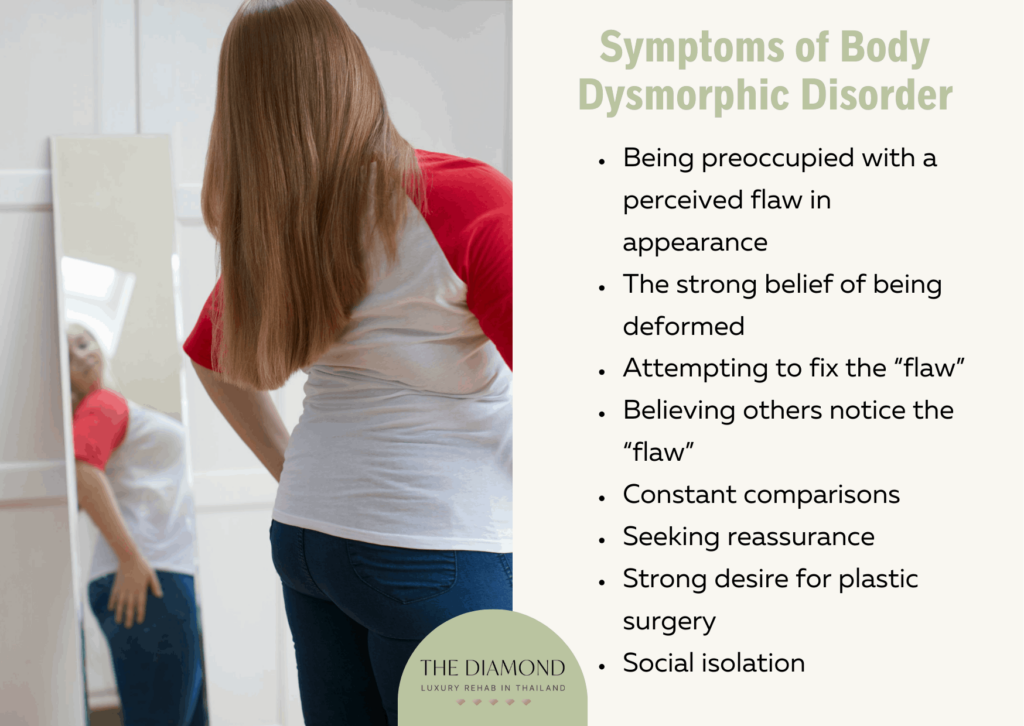
Symptoms of body dysmorphic disorder manifest as a preoccupation with perceived flaws or defects in physical appearance that are not observable or appear minor to others. The symptoms of body dysmorphic disorder are listed below.
- Being preoccupied with a perceived flaw in appearance: Focusing excessively on the supposed flaw and constantly talking about it, even when others see nothing wrong.
- The strong belief of being deformed: A person with BDD is convinced their appearance is flawed and views themselves as being deformed or ugly.
- Attempting to fix the “flaw”: An individual with BDD constantly engages in behaviors that focus on fixing or hiding the “flaw” in their appearance. These behaviors include checking oneself in the mirror constantly, skin picking, grooming, etc.
- Believing others notice the “flaw”: To a person with BDD, their appearance-related problem seems so big that they believe others see it too. Not just that, they additionally believe others stare at them, mock them, and notice their appearance in a negative manner.
- Constant comparisons: People with BDD tend to compare themselves and their appearance to others.
- Seeking reassurance: Since a person with BDD is convinced their appearance is flawed in a way, they constantly ask others about it. While doing so, they seek reassurance i.e., want other people to tell them nothing is wrong or that their problem isn’t obvious/visible.
- Strong desire for plastic surgery: To someone with BDD, plastic surgery is oftentimes the sole solution to fix their appearance. Even if they undergo a cosmetic procedure, individuals with body dysmorphic disorder don’t stop there. Instead, they’re convinced they need to do more. This leads to multiple cosmetic procedures, and to others, it seems the person is obsessed with plastic surgery.
- Social isolation: Due to a strong belief in flawed appearance or that others see it too, a person with BDD strives to avoid social activities as much as possible. When around people, they feel anxious.
What are the causes of body dysmorphic disorder?
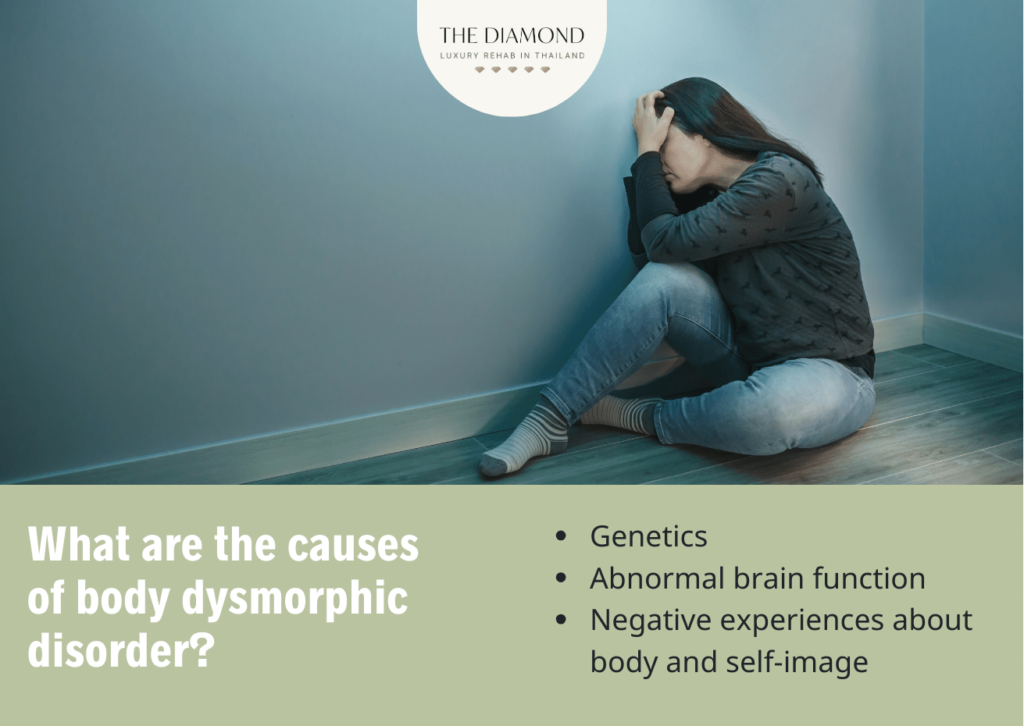
The causes of body dysmorphic disorder are generally unknown. A combination of different issues contribute to the development of BDD, like with other mental health conditions. The most common causes of body dysmorphic disorder are listed below.
- Genetics: Genetic predisposition or vulnerability contributes to the development of body dysmorphia symptoms. At this point, specific genes or genetic mutations and pathways that play a role in body dysmorphic disorder are unknown. A 2014 study by Monzani et al., from JAMA Psychiatry found that certain aspects of obsessive-compulsive disorders, including BDD, are strongly influenced by genes. Potentially, this explains the familial nature, comorbidity patterns, and phenomenologic similarities observed in the literature. The same study revealed certain disorder-specific genetic influences that are evident in BDD and some other OCDs. That means it is highly likely there is a set of disorder-specific genes that contribute to the development of BDD.
- Abnormal brain function: Impaired function in parts of the brain and imbalances of certain neurotransmitters may contribute to body dysmorphic disorder. For example, Psychological Medicine published a study by Li et al., in 2015 that found that people with BDD exhibited higher activity in brain areas that process detailed information. The greater activity they had in detail-processing areas such as the fusiform cortex, the less attractive they perceived the faces to be. Furthermore, those with BDD additionally displayed anomalies in functional brain connectivity with the orbito-frontal cortex, a region typically linked to OCD pathology; this connectivity is associated with OCD symptoms in BDD, according to a study by Beucke et al., published in the October 2016 issue of the European Neuropsychopharmacology.
- Negative experiences about body and self-image: A person’s environment plays a significant role in the development of body dysmorphic disorder. Negative experiences in childhood such as teasing, bullying, neglect, and abuse (physical and/or verbal) affect the way a person perceives their appearance. As a result, they adopt negative body image and unrealistic expectations that pave the way to body dysmorphic disorder.
What are the risk factors for body dysmorphic disorder?
Risk factors for body dysmorphic disorder encompass a combination of genetic, biological, psychological, and environmental influences. The risk factors for body dysmorphic disorder are listed below.
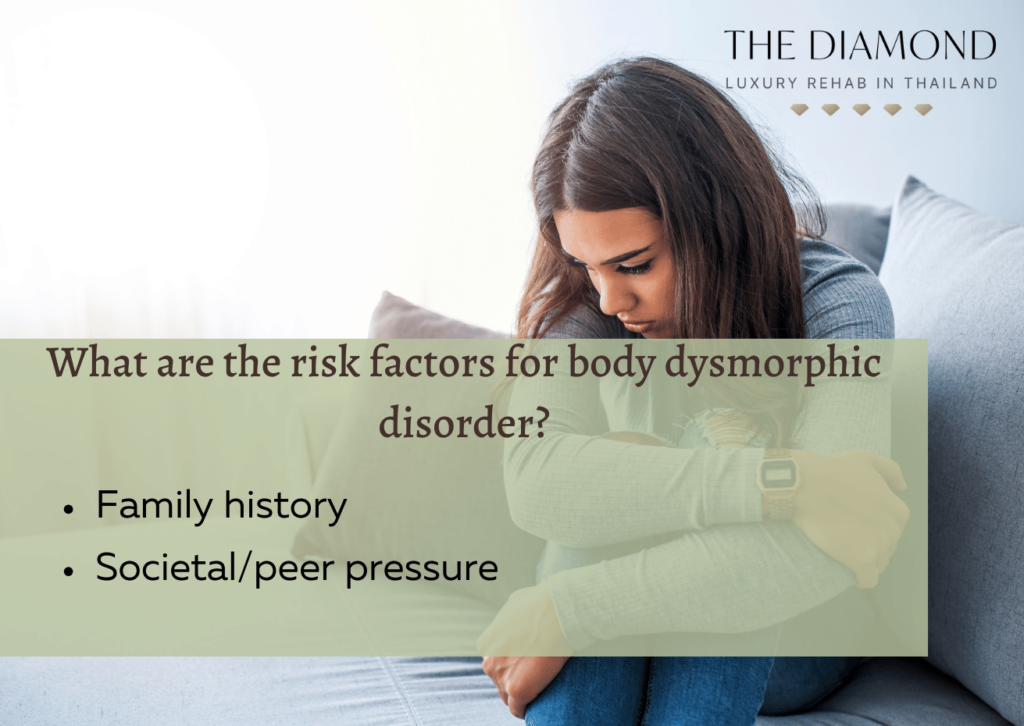
- Family history: a person is more likely to develop body dysmorphic disorder if their family members have it as well. It’s difficult to determine whether symptoms are inherited from genes or picked up from parents’ behaviors.
- Certain personality traits: people with introverted, insecure, sensitive, narcissistic, and perfectionist tend to be at a higher risk for body dysmorphic disorder. For example, perfectionists have a strong drive for perfection in everything they do, including their appearance. They may perceive some facial features or their bodies as flawed i.e. not perfect.
- Other mental health problems: persons with other mental health conditions such as anxiety or depression are at a higher risk of developing body dysmorphic disorder as well. Mental health conditions make a person more vulnerable to negative thoughts, including those about their appearance. Also, sometimes it’s unclear whether BDD contributes to anxiety or depression or they cause body dysmorphic disorder.
- Societal/peer pressure: social pressures (from social media, TV, and society in general) and peer pressure at school nourishing unrealistic or unhealthy beauty standards put a person, especially an adolescent, at a higher risk for BDD. With continued exposure to unhealthy and negative beauty expectations and standards, a person becomes more inclined to think something is wrong with their appearance and that only plastic surgery can fix it. Societal pressure would lead to self-consciousness and strong dissatisfaction with one’s look, even if one accepted these supposed “flaws” in the past.
- Traumatic events or emotional conflict: victims of bullying in school and children who were abused or neglected are more susceptible to developing BDD. Their body image has been greatly affected. Plus, their traumatic events have taken a major toll on how they perceive themselves compared to other people. An affected individual may believe something is wrong with them or they’re not worthy of respect or love unless they change their appearance.
How common is body dysmorphic disorder?
Body dysmorphic disorder is quite common. A 2010 paper by Bjornsson et al., published in Dialogues in Clinical Neuroscience reported that point prevalence in the general population ranges from 0.7% to 2.4%, according to epidemiologic research. According to these findings, BDD is more prevalent than conditions like anorexia nervosa or schizophrenia.
The Office on Women’s Health additionally reported in its article titled, “Body dysmorphic disorder” last updated in February 2021 that BDD affects one in 50 people. The number of people with body dysmorphic disorder in the United States is between five and 10 million. However, BDD is largely underdiagnosed mainly because numerous people are reluctant to seek help for their symptoms and, thereby, don’t receive a diagnosis.
How is body dysmorphic disorder diagnosed?
Body dysmorphic disorder is diagnosed after taking a personal and family medical history and performing a physical exam. If a healthcare provider suspects a person has BDD, they’re going to refer them to a psychiatrist or psychologist.
The mental health professional evaluates a patient’s behavior, attitude, and symptoms they’re experiencing. They give a diagnosis of BDD when a patient is preoccupied with a flaw (or more of them) in their appearance or when they can’t function at work/ home due to worries about their look and do repetitive actions due to concern for their appearance. These repetitive actions include checking oneself in the mirror constantly and grooming.
Generally speaking, body dysmorphic disorder is difficult to diagnose because people feel ashamed and tend to be secretive about their symptoms. The embarrassment makes them reluctant to schedule an appointment to see a healthcare provider. For that reason, BDD often goes unnoticed for several years, and affected people never receive a diagnosis and treatment.
How to prevent body dysmorphic disorder?
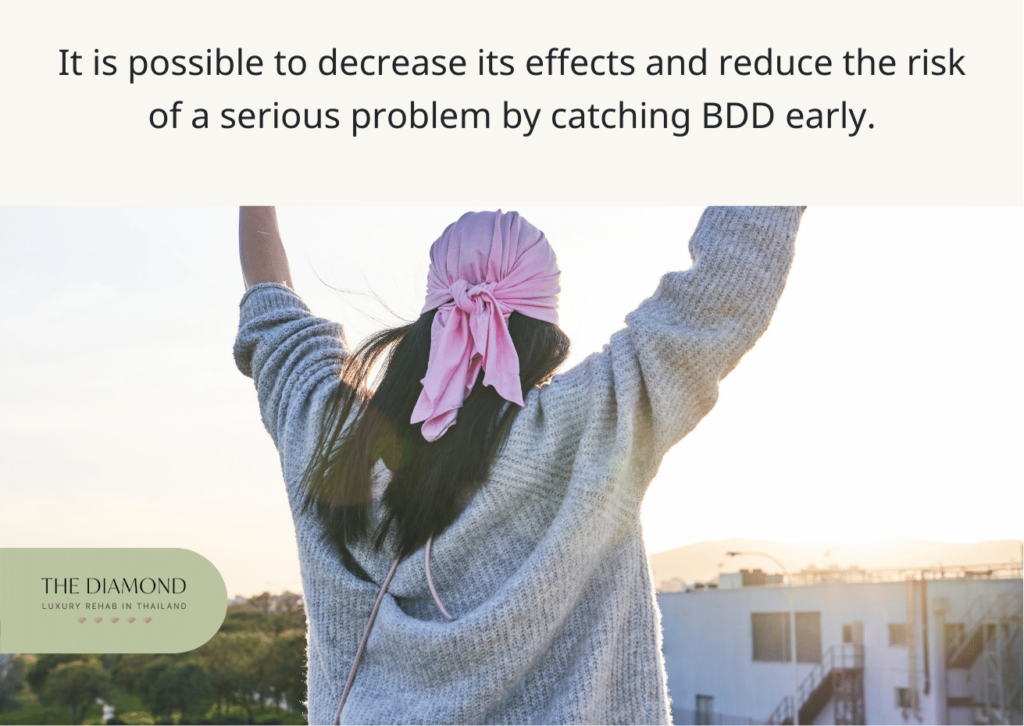
It is not clear how to prevent body dysmorphic disorder at this point. There is no known strategy to avoid it. However, it is possible to decrease its effects and reduce the risk of a serious problem by catching BDD early.
Since body dysmorphic disorder starts in early adolescence, early diagnosis and timely treatment are both extremely beneficial. Long-term maintenance treatment additionally prevents relapse of BDD symptoms.
When it comes to reducing the risk of BDD, society itself plays an important role. Unhealthy beauty standards presented by social media and the entertainment industry are major contributors to insecurities that lead to BDD.
For that reason, putting a strong focus on healthy and realistic attitudes about body image is necessary. As people, especially adolescents, learn to accept themselves and their bodies, they become less likely to experience symptoms of BDD.
That being said, body dysmorphic disorder is more than that, which is why there is no specific strategy that protects a person from developing it ever. Getting educated and informed about BDD and its symptoms helps people, particularly parents, recognize them and encourage an affected person to seek help before it becomes worse.
What effects does BDD have on a person’s life?
The effects of BDD on a person’s life are substantial and far-reaching, affecting many elements of their daily functioning and overall health. The effects of BDD on a person’s life are listed below.
- Anxiety
- Depression
- Suicidal thoughts and behavior
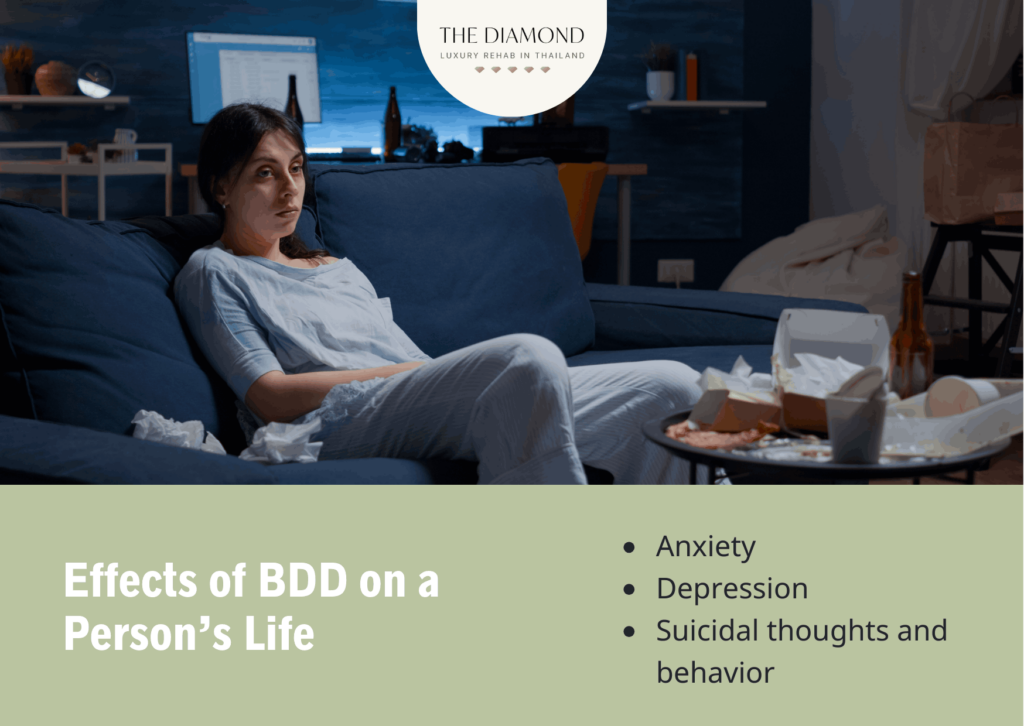
1. Anxiety
Anxiety is an intense feeling of dread, unease, fear, and worry. While it is possible for everyone to be anxious from time to time, anxiety as a mental health disorder tends to be debilitating.
Since BDD is a type of anxiety disorder, it’s not surprising that anxiety is a major effect or complication of this condition. For example, a study by Hakim et al., published in the October 2021 issue of the Journal of Taibah University Medical Sciences found that body dysmorphic disorder is linked to stress and anxiety and is rather prevalent among college students.
Meanwhile, a 2010 paper by Angela Fang and Stefan G. Hofmann published in the Clinical Psychology Review found a link between BDD and social anxiety disorder, especially in Eastern cultures. Since a person with BDD is convinced something about their appearance is wrong, they develop anxiety that affects their social functioning.
Generally speaking, anxiety results from traumatic events and other negative experiences. As an anxiety disorder, BDD has this component since negative experiences are risk factors for this disorder.
The symptoms vary, but a person tends to become nervous and restless. Other symptoms include hyperventilation, increased heart rate, sweating, trembling, and difficulty controlling worry. When left unmanaged, irrational thoughts associated with body dysmorphic disorder become more intense and lead to anxiety symptoms.
2. Depression
Depression is a serious mental health disorder characterized by persistent feelings of sadness, hopelessness, and helplessness. It affects how a person thinks, feels, and behaves. A 2022 study by Kang et al., published in Frontiers in Psychiatry stated that the research on the relationship between BDD and depression is contradictory; certain studies claim that those with BDD are 2.3 — 4.2 times more likely to suffer from co-occurring neuropsychiatric disorders, particularly depression.
It’s highly unlikely BDD is a symptom of depression, but it contributes to it as well. Recognizing depression in patients with BDD is difficult because its symptoms are often concealed due to shame and embarrassment.
When left untreated, body dysmorphia leads to severe depression. That happens because a person’s perception of their appearance keeps getting worse, and so do the symptoms of BDD. In this situation, a person feels like there is no way out because even if they get plastic surgery, they are often still unsatisfied with the results. This leads to desperation and depression.
Plus depression is caused by various factors, including low serotonin, which happens to be one of the causes of BDD.
A person with depression is constantly sad, loses hope, thinks they’re worthless, loses interest in activities they used to enjoy, and becomes socially isolated.
3. Suicidal thoughts and behavior
Suicidal thoughts and behaviors are consequences of a serious underlying problem. The BDD Foundation, in its publication titled, “Feeling Suicidal?” stated that about 25% of BDD patients who visit a specialized clinic report having tried suicide at a certain point in the past. According to a different survey, 0.3% of BDD sufferers attempt suicide annually.
Living with body dysmorphic disorder is extremely difficult. Affected people experience high levels of distress and feel hopeless. They develop depression which keeps getting worse. For certain patients with BDD, the sole solution is suicide, which is why suicidal thoughts and tendencies are the scariest complications of this disorder.
A 2007 paper by Katharine A. Phillips published in Primary Psychiatry confirmed that though it is still in its early stages, empirical research on suicidality in BDD suggests that suicidal thoughts and attempts are frequent in this condition. Symptoms of suicidal thoughts and behaviors include talking about suicide a lot, social isolation, mood swings, feeling trapped or worthless, and engaging in self-destructive behaviors.
What are the treatments available for body dysmorphic disorder?
Treatments available for body dysmorphic disorder are individualized and require the collaboration of numerous specialists. Treatments available for body dysmorphic disorders are usually, a combination of the approaches listed below:
- Cognitive-behavioral therapy
- Selective serotonin reuptake inhibitors (SSRIs)
- Medication
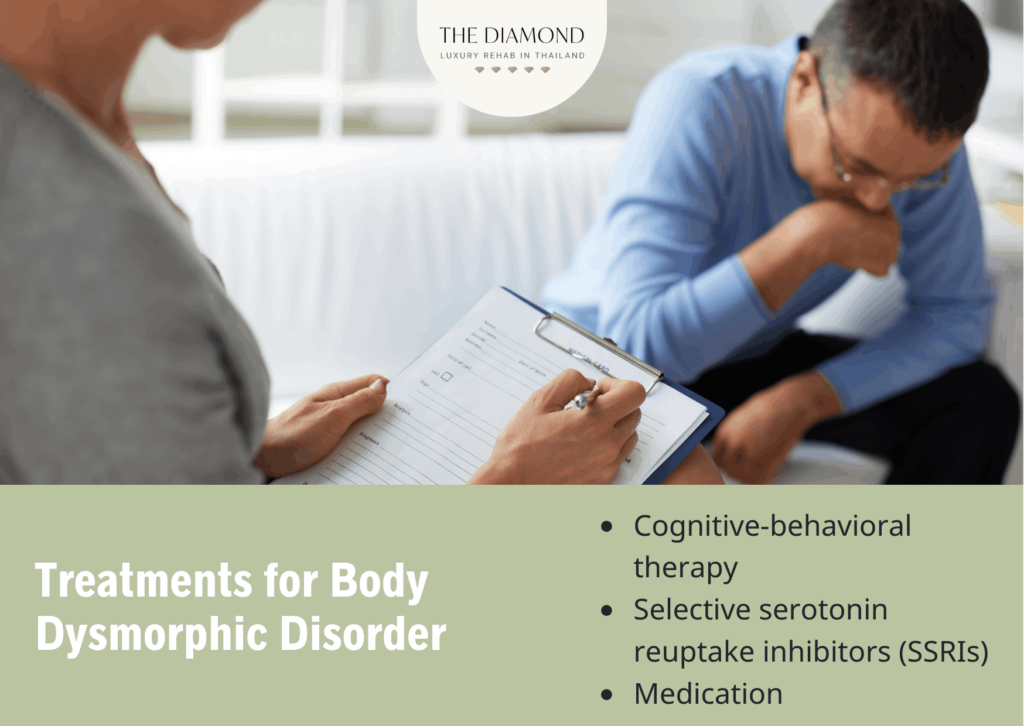
1. Cognitive behavioral therapy
Cognitive-behavioral therapy (CBT) is a form of talk therapy that helps people change the way they think and behave in order to manage or treat a certain problem. During CBT sessions, therapists help patients identify negative or irrational thoughts and beliefs.
The main premise of cognitive-behavioral therapy is that negative thoughts lead to negative emotions and behaviors. So by changing their thinking pattern, a person improves their emotional health and their behavior at the same time.
As the first-line treatment for BDD, cognitive-behavioral therapy helps patients challenge their negative thoughts and body image. As a result, they start replacing irrational thoughts or beliefs with a more realistic outlook. In other words, this type of talk therapy enables patients to adopt more flexible ways of thinking.
Patients additionally learn coping skills to handle symptoms of BDD, such as mirror checking, excessive use of medical services, and seeking reassurance.
A 2013 study by Prazeres et al., from Neuropsychiatric Disease and Treatment found that CBT reduced anxiety and depression in BDD patients as well as OCD symptoms related to body dysmorphia.
Additionally, Clinical Psychology Review published a paper by Harrison et al., in 2016 confirming that CBT is an effective treatment for BDD. The therapy reduced depressive symptoms, delusions, and improved insight.
Since numerous people with BDD develop anxiety, especially social anxiety disorder, the therapist works with the patient on improving social skills and interpersonal interactions.
2. Selective serotonin reuptake inhibitors (SSRIs)
Selective serotonin reuptake inhibitors (SSRIs) are antidepressants. In fact, they’re the most commonly prescribed medications for the treatment of depression. These drugs work by increasing serotonin levels in the brain, hence the term “selective” – they don’t act on other neurotransmitters. More precisely, SSRIs inhibit the absorption of serotonin into neurons. As a result, more serotonin is available for better transmission of messages between neurons.
Doctors prescribe SSRIs to patients with body dysmorphia because decreased levels of serotonin play a significant role in the development of this condition. Plus, in certain cases, body dysmorphia and depression overlap, meaning SSRIs help patients manage their symptoms. The role of SSRIs is to help patients control their thoughts and behaviors more effectively.
3. Medication
Medications are one of the treatment options available for body dysmorphic disorder (BDD), particularly in cases where individuals experience co-occurring symptoms of depression, anxiety, or obsessive-compulsive disorder (OCD).
Healthcare professionals prescribe other medications to manage BDD. The specific medications depend on the symptoms, but the above mentioned SSRIs are the most common pharmaceutical treatments for this condition.
Besides SSRIs, certain patients need clomipramine, a tricyclic antidepressant with strong serotonergic action. The main objective of medications is to reduce the intensity of symptoms and improve a patient’s quality of life.
Is it possible to treat body dysmorphic disorder?
It is possible to treat body dysmorphic disorder in a way to improve symptoms and quality of life, but the condition itself doesn’t have a cure. There is no specific medication or therapy that totally eliminates body dysmorphia.
Patients with BDD need a well-structured treatment protocol whose main goal is to reduce the effect of symptoms on a person’s life in order to improve their functioning at work/school, at home, and in social settings.
The most important thing to remember, according to an article titled, “Body dysmorphic disorder (BDD)” last reviewed in October 2023 by the UK’s National Health Service, is that it is possible for the symptoms of body dysmorphic disorder (BDD) to improve throughout the course of treatment.
However, patients need to be persistent and adhere to the treatment in order to maintain their progress and other positive results. That’s why a strong support system is necessary for a person who’s recovering from body dysmorphic disorder.

